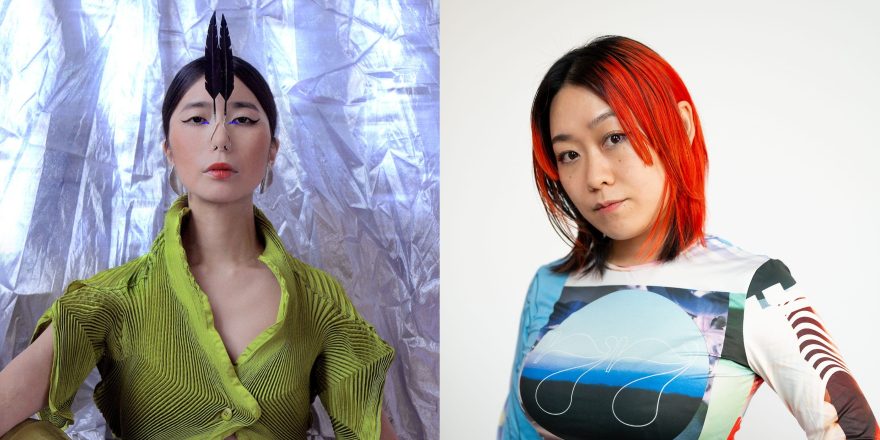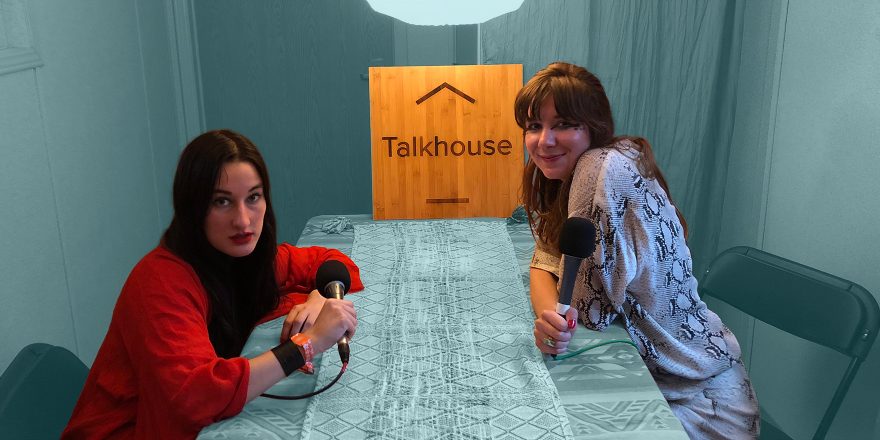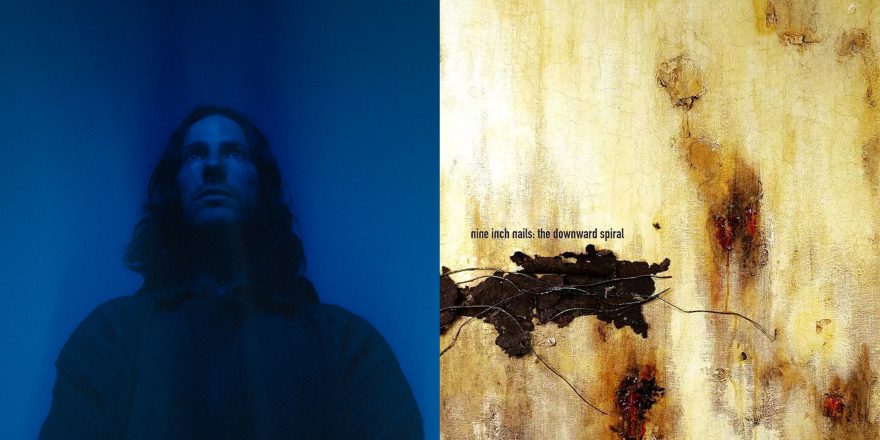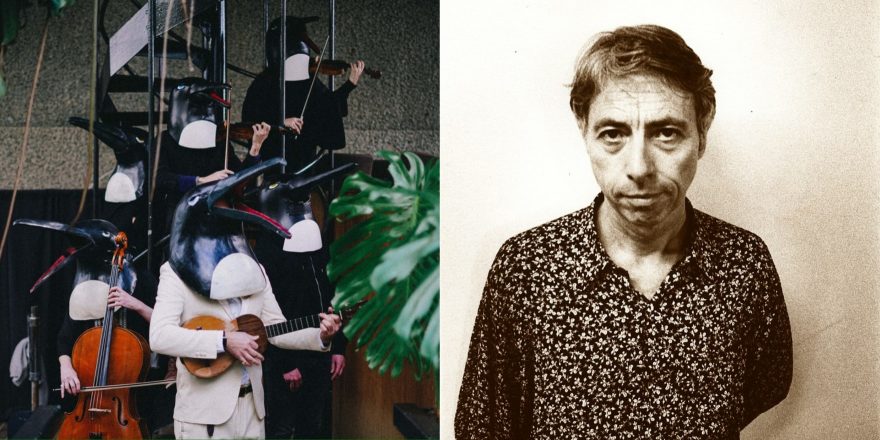NAOWAO, aka Nao Sakamoto, is a Berlin-based Taiwanese/Japanese multidisciplinary artist; Hatis Noit is a Japanese vocal performer, now based in London. Hatis recently collaborated with Nao on a video for her song “Jomon,” so to celebrate, the two got on a Zoom call to catch up about the genesis of it, and more. Hatis’s new record, Aura, is out now.
— Annie Fell, Editor-in-chief, Talkhouse Music
Nao Sakamoto: It’s the first time talking to you after the video — or, actually, after the kick off meeting — so I’m super excited to talk to you.
Hatis Noit: I’m very much excited about it too.
Nao: Can I get your impression of the video directly from you?
Hatis: It’s just amazing. I mean, the first time I watched the video, it was still a demo, but I was totally blown away and I kept saying, “Oh my god, oh my god, this is incredible. She’s a genius.” It’s so beautiful. The first time I saw the document you created—
Nao: Oh, yeah, with the script and the whole world design.
Hatis: It was just amazing. It was so much more than I expected, so much [more] detailed. I was so happy to see that someone would take it so seriously. And then I could see you also enjoyed the process of creating the video, right?
Nao: Yeah, definitely. Totally. First of all, I’m so happy to hear that. I really appreciate your trust in the process, because I was actually wondering when I sent you the whole script in the beginning if you actually liked the direction. Because that was the first pitch after having the kickoff meeting, asking you different questions about the process of your creation of “Jomon” and your emotional curve to it. But after listening to your approach to the music, that you wanted to tell the emotional story of how people lived in that Jomon time, that was exactly what I needed. I really wanted to create our own version of mythology, and I’m very happy that you liked it and trusted me to create this whole world.
Hatis: Yeah, I mean, I was more than happy. Because when I make music, even though there are so many inspirations that I’ve got from my life or readings or watching movies, I don’t really express that so clearly in my music. I personally find that the beauty of music is [that] we can keep it vague, so that people can imagine their own world with the music. I love providing the space for them to imagine something on their own. Of course, if someone asked me what’s the inspiration behind the music, I can answer to it. But I don’t really verbalize it in my music, especially when I don’t use any [lyrics]. But what you created after our meeting was totally the world I visualized. I was so happy.
Nao: Yeah, that was definitely like my version of experiencing your song. Because I remember when I first saw your performance in Berlin at the end of the year, in 2022, at the Erased Tapes concert, I totally felt transcended through time and space. I saw you as kind of like a shaman. Like you said, everybody feels something different from your songs and performances, so maybe this video was something from what I felt. [To me, it felt] kind of related to animism — a culture which happened around that Jomon time. But also, animism was not just in Japan or Asia, but also in Africa, the Middle East, Europe. So I think even though I felt my own version of experience through your performance, there’s a lot of similarities of what everybody felt, and I hope that this video could be something like that as well.
Hatis: Definitely. I mean, animism — the energy of nature and, not just human beings, but also any kind of creature — is one of the biggest inspirations for my music. Especially [because] I am from Hokkaido in Japan, which is filled with beautiful nature and wild animals and stuff. When I made this song, we were dealing the lockdown because of COVID, and at the time, I really struggled with connecting to myself, or to be inspired to make any new music, even though I had so much time at home. It was kind of an ideal situation for artists, especially touring artists who usually don’t have time to be in the studio, to be focused. [But] at the time, I couldn’t even be focused to make new music. But one day, I was sitting in the room I was using as a studio. I still felt quite empty and I had no idea what to make, but just spontaneously, I looked out of the window and I saw a tiny squirrel.
Nao: Yeah, I remember that.
Hatis: [Laughs.] And then, I don’t know, somehow it was…
Nao: Just like a reset, right?
Hatis: Yes. It was kind of a mind blowing moment to me. It was eye-opening. Because at the time, I felt like my world was just happening within that tiny room. Other than that, the world was gone completely. I felt so alone, and so disconnected from the world, nature, and other people even. And just the tiny squirrel made me realize, OK, outside of this window, the world still exists. And even as humankind struggles so much with this crisis, nature is still out there and the animals don’t care. At that time, I felt like it was the end of the world — but it wasn’t, because from the point of view of our long natural history, this is just a really tiny moment. It isn’t even a crisis, maybe, [in the context of] history. And then I realized, we were also just a part of this vast nature, and the world is still so beautiful and vibrant and still so alive. I started thinking in the room alone, and I started remembering our original energy as a creature. Not just human, but just as an animal; very raw, primitive energy. And I made this song “Jomon.” I always make my songs by improvisation, so when I started singing, I had no idea what kind of song I was making.
Nao: Yeah, you just have kind of a concept as a base?
Hatis: Yeah, yeah. And I just go with the flow, you know? The first time I came up with the sketch of “Jomon,” singing alone, I was just naturally crying to remember the energy of, OK, I am still alive… [Laughs.]
Nao: I think that’s totally related to the concept of animism, to feel like you are one part of the integral environment — nature — and then to feel the interconnectedness as just living beings with the surroundings. And, yeah, I think it’s really hard to feel that when you’re living in the modern city, not in nature. But moments like when you saw the squirrel — or for me, for example, going into nature and getting into the hot springs naked is like melting in nature, feeling like I’m part of this whole world. I think that simple feeling is like a link to animism. I wanted to ask you: you said you improvised to make “Jomon,” and when I first heard the music, I totally thought it’s for a ceremony or ritual — as it became like in the video. What was your feeling after you finished making the sketch?
Hatis: Oh, yeah, definitely. It was the first time for me to remember, I am alive. At that time, I felt so like I was just a body without a spirit. I didn’t feel I was living at that time. And yeah, actually, it became a ceremony for me to remember I am alive, and even when I felt so disconnected to the world, I’m still a part of this nature. And for me, by singing, I can remember that I am connected to everything, including nature and other people, other creatures.
Nao: That’s amazing.
Hatis: It was a beautiful experience.
Nao: Yeah. And it’s so beautiful that you feel that when you’re making the music, but as an audience, I think we can feel the same as well.
Hatis: Yeah, hopefully. I’m very happy to hear that. I actually have also a question for you regarding the script you made: I could see lots of inspiration from the Jomon time, or animism. I remember a couple of stories behind the characters — for instance, for one you wrote something like “eating spirits.” [Laughs.]
Nao: [Laughs.] Yeah, we were discussing if we wanted to include that in the video or not, the cannibalism aspect.
Hatis: Yes, yes.
Nao: I like to do some research when I’m designing the worlds, and for this one I did some research about that Jomon era and some symbolism that the Jomon people used for their ceremonial figurines or pottery. You can see that there’s a lot of swirls and some patterns with waves, or fire. You never know if it’s right or wrong, because you can’t ask them right now if they made it for some reason or for just some artistic style, but anthropologists think that it’s symbolism for the animals they saw as a representation of immortality or reproduction or regeneration. Because at that time, for sure, it was really hard to live, so they saw some hope in, or prayed to, those animals or nature elements. Researchers think the symbols are related to, for example, snakes, because they shed and they hibernate. Or some Japanese texts say it’s related to frogs also, because of how they transform from baby to adult.
And so I thought, OK, that’s a very interesting theme about reproduction and regeneration, because life is like that, right? A soul can die, but it could be coming alive again in the next life. I really like that whole cycle of life aspect. So then I got interested in looking for animals that I can get inspired to create the creatures. When I was reading about axolotls, they eat each other’s limbs to live. I thought that was an interesting thing and I wanted to make our own version of symbolism related to that. So that’s the main inspiration of the cannibalism aspect — like, it’s in their nature, but maybe it can be a symbol of reproduction, regeneration, as part of the whole living beings.
Hatis: That’s so interesting. And what did you say? Axolotls?
Nao: Axolotls. In Japanese, it’s uparupa.
Hatis: Uparupa! [Laughs.]
Nao: [Laughs.] They’re like amphibians. I remember that in Aztec mythology, they are also a symbol of defying death.
Hatis: Wow, that’s so interesting. Just by chance, I went to Mexico last year, and I saw some Aztec ruins in the city and it was so beautiful. I was so impressed to see how close that it was to them in their life. In my life, death is one of the most inspiring thing to think about, ever since I was a kid.
Nao: Yes.
Hatis: It’s like when I went to Nepal, when I was probably 16 or 15 years old, and I was really shocked to see — you know, it’s like in India, how people burn dead bodies along the river. We could see human bodies burning, and we could smell the smoke from it. I was so, so shocked, because I was raised in Japan and in usual life in Japan, we don’t see death in front of us so vividly, so closely. But in contrast, I saw human bodies and death itself so closely that I could even smell it. The whole experience, and especially the smell, was so strong that I got traumatized. After that, for a while, I really didn’t feel like doing barbecue, you know? [Laughs.] It’s so strong, and very similar to the smell of barbecue, but it’s a human body. I couldn’t really handle that.
Since then, I came to think about death, and why in our modern world we treat death as a taboo. Once we see death so closely, our world would change completely. We realize death is so close to life. And, actually, I don’t know if you are Buddhist and if you believe in reincarnation, but to me, it completely makes sense that life and death are a continuing, circular thing. I often dream of the death of myself, and after my death I see a vision that my body will be dissolved into the soil again, and probably become nutrition for the next generation of trees, or I might be eaten by worms.
Nao: Or mushrooms. [Laughs.]
Hatis: Yeah. It’s such a beautiful thing to me. If we don’t think about death, we don’t see the world like this.
Nao: Yeah. I’m also really interested in the topic of death and how it’s so different in different cultures. Of course, religious-wise, but also scientific-wise. But just as a topic, I think it’s very interesting how people approach it, and a lot of people are kind of afraid to talk about or think about death. I’m also really similar to your approach, that death is very close to us. My father passed away when I was 12, and it’s been almost 20 years already, but I’m still figuring out how to approach it. And that’s another reason why I’m researching how different cultures approach death. It’s so interesting, and especially if you also consider the Jomon people or that time it’s so fascinating. And even in Japan, they celebrate the Obon and they invite the spirits to dance in a circle, and every soul or spirit becomes part of the same dance party. And in Mexico, it’s also a celebration.
Hatis: Yeah, right. I have very similar story with my father — my father also passed away when I was in my early 20s. But because of my family history, I didn’t really see my father before he died, so I didn’t really know what my father was like. Actually, the first time I saw his face, what he looked like, was his funeral.
Nao: Oh my god.
Hatis: Yeah. But it’s been such an interesting relationship we are having after his death. I feel like we started a new relationship after his death. Do you know what I mean?
Nao: Mhm.
Hatis: Probably because I couldn’t have a proper relationship with my father when he was alive, so his funeral was actually the starting point for us. After his death, I’ve been talking to him in my imagination. I’ve been talking to him, I’ve been imagining how he reacts. Actually, I have been taking part of his ashes everywhere where I go for tour. I just want to show him where I am, and share my experience. If he was alive, we couldn’t have such experiences. But now he’s just ash, so I can take him everywhere. [Laughs.]
Nao: [Laughs.] That’s good that you have a new relationship with him like this.
Hatis: I know, and I think this relationship is equally rich to the relationship which we can have with someone alive, you know?
Nao: Yeah. That’s very interesting. What about his voice? Have you heard his voice? And when you talk to him now, do you hear his voice, or it’s just more like an abstract conversation?
Hatis: Yeah, I would hear some messages, but I can’t really imagine his voice. I don’t remember it and I didn’t really hear it.
Nao: For me, my memory — of course it’s fading, and it was very sad when I started forgetting his voice. Because for me, I remember the visual more than his voice. But sometimes when I hear pop music from around that time, I start to remember the memory more. The music helps me tap into my memories from that time, and I remember he sounded. It’s the memories, but also the new conversation that you have, as you said, is interesting. That reminds me of the saying “memento mori” — when you forget, then that person is dead forever, but as long as he’s alive in your stories, then he’s alive as well.
Hatis: Oh, so beautiful. I’m very happy that we can share this kind of story as well.
Nao: Yeah.
Hatis: I was also really happy to see you put the character of the mantis in the video.
Nao: Yes, of course! Of course we wanted to put that in. Can you tell the story again?
Hatis: Yeah. When I was in Lisbon, I had a performance in a field. It was evening, in the dark, and then — this kind of thing often happens when I have a live performance, some wild animal comes.
Nao: You’re like a Disney princess. [Laughs.] But a better one.
Hatis: [Laughs.] I don’t know, yeah. That squirrel, and [there’s been] dogs, cats. But at that time, it was a mantis. And it was actually a huge mantis, but I hadn’t realized what it was — I just felt something on my head when I was singing. I noticed the people in the audience were freaked out, and in the end, I noticed that it was a mantis. I just thought I felt some itchiness, but I didn’t really care. I kept singing, and at some point, I raised my hand, and at first I was a bit surprised to see such a huge mantis on my head. But [then I was like,] “OK, welcome to my space.”
Nao: “Welcome to the performance, let’s perform together.”
Hatis: Yeah, “why don’t we sing together and dance together?” I was playing around with this mantis, and it became a story of the festival.
Nao: Yeah, we wanted to definitely include that. And because of the scale, even though the mantis is huge, it’s one of the insects, and we also wanted to show tiny creatures can be part of a big energy also. So the mantis was a very important aspect in the video, scale-wise, to incorporate that tiny, alive being. Also, when I was researching, mantises have a big importance in mythology in different cultures as well. It’s a very spiritual element.
Really random, but what’s your favorite creature or animal that exists in this world?
Hatis: Ah, I love black panthers.
Nao: Black panthers!
Hatis: Yeah, I really love panthers, especially black ones. I remember when we were talking about our spirit animals and we were guessing each others’, someone said mine should be a black panther and I felt so good about it.
Nao: Yeah, it’s really nice. Independent.
Hatis: And very elegant, strong. How about yours?
Nao: Well, I don’t know if it’s because I tell everyone about this, but because I like sea slugs so much, my friend told me my spiritual animal is a sea slug. [Laughs.] And I accept that, I’m happy! It’s colorful, funky, and gender neutral — because a lot of people say I’m a bit masculine inside.
Hatis: I love the sea slug character in the video too. So cute. Do you have a favorite character in the video?
Nao: You! [Laughs.]
Hatis: [Laughs.] How sweet. Do you also see yourself in the character of me? As a human…
Nao: No, I see myself more in the sea slug character. [Laughs.]







